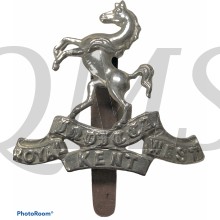Cap Badge Royal West Kent Queens Own (Royal West Kent Regiment) RWK
The 1st Battalion was part of the 10th Infantry Brigade of the 4th Infantry Division. Soon after the outbreak of war in September 1939, the battalion was sent to France where it became part of the British Expeditionary Force (BEF). Unlike in the Great War the battalion was not immediately in action, and the first few months of the conflict were spent digging trenches and defensive positions in expectation of a repeat of the trench warfare of the Great War. In early May 1940 the battalion was transferred to the 132nd Infantry Brigade of the 44th (Home Counties) Infantry Division, a TA formation which also included the 4th and 5th Battalions.The battalion fought in the Battle of France and the subsequent retreat to Dunkirk soon after, returning to England via the Dunkirk evacuation, but had suffered heavy casualties, including the loss of two rifle companies. After returning, the battalion was again transferred, in September, to the 12th Infantry Brigade of the 4th Infantry Division. It remained in the United Kingdom, mainly engaged in anti-invasion duties, coastal defence, and training for future combat operations until February 1943, where the battalion left for French North Africa, arriving in Algeria in March, to take part in the final stages of the Tunisian Campaign. The battalion, in late April, suffered over 300 casualties assaulting Peter's Corner and Cactus Farm. The campaign ended in mid-May 1943, with over 238,000 Axis soldiers surrendering. The battalion remained in North Africa, were, due to its heavy losses in Tunisia, it served as a reserve battalion, sending drafts of soldiers to other units as battle-casualty replacements. It remained in this role until late 1943, and in February 1944, the battalion, now up to strength again, was sent to the Italian Front, and fought in the Fourth Battle of Monte Cassino and, after pursuing the retreating German Army, where they helped breach the Trasimene Line, took part in the battles for the Gothic Line. In December 1944, the battalion was transferred to Greece to help maintain order after the German withdrawal and the subsequent break out of the Greek Civil War.
The 2nd Battalion was part of the garrison of Malta during its protracted siege. It then formed part of the 234th Infantry Brigade in the abortive assault on the Italian-held Dodecanese islands in 1943, being captured by the Germans on the island of Leros. The prisoners were transported in cattle trucks from Greece to Wernigerode, in the Harz Mountains, where they were forced to work in support of the German war effort. The battalion was reconstituted in 1944 by amalgamating the few remaining survivors (less than 100 officers and men) with the 7th Battalion and redesignating it as the new 2nd Battalion. The 7th Battalion had been a training and draft finding formation assigned to the 211th Infantry Brigade, which was part of the 80th Infantry (Reserve) Division. In July 1944, the new 2nd Battalion was assigned to the 184th Infantry Brigade attached to the 61st Division, with which it remained for the rest of the war on home defence duties. In August 1945, the battalion-as well as the division-was preparing to be sent to the Far East, but the move was cancelled when Imperial Japan surrendered ending the war.



